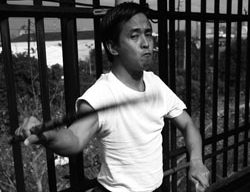With few exceptions, stick fights with unpadded sticks without the aid of helmet and armor do not last very long. Its either one fighter surrendered or suffered a knock out or the referee stopped the match because of the severity of the injury. This is the norm that the escrimadors of yore have to live with hence in the old Philippines; it is not common for escrima and arnis men to practice in seclusion for the fear of being challenged.
In his book “The Filipino Martial Arts,” Dan Inosanto describes how a juego todo (all-out stick fighting match) was conducted as per the accounts of the late death match master Floro Villabrille, it reads, “They usually used the stick in the right hand and punched with the left hand.
The use of the elbow, knee and head were common at close range combat. Combat grappling like techniques (standing or on the ground) were applied. These included throws, trips, sweeps, take downs, chokes, strangulation, dislocations and locks on fingers, wrists, elbows, shoulders ankles and knees. The feet were used for kicking at low level.
It was a brutal art and only the swiftest, the strongest and the most courageous survived or remained in practice. The rounds were two minutes with one minute rests in between.”
Inosanto’s book also has a graphic description on the kind of injury a fighter can sustain from such matches. In a match fought by the late Angel Cabales, it says, “Stick fights never last very long and this one ended when Cabales broke open the man’s knuckle. The blow lacerated an artery and the blood pumping out of the man’s hand kept him from continuing.”
The breed of escrimadors who have experienced the brutal nature of juego todo and the battlefield were forced to choose practical over fancy techniques, for survival not aesthetics is the primary concern in actual combat.
The problem with martial arts that developed during peaceful times is that they lacked the necessary pressure testing. In times of war, a fighter is forced to pick techniques that only work for real. In peaceful times, a martial artist possesses the luxury to tinker with creativity in formulating fighting techniques but whether these techniques will work for real is another story.
The basics of the Filipino martial arts (FMA) were designed to be conveyed easily and learned fast. The reason for this is because in pre-colonial times when an invasion of a barangay by another barangay is impending, it is a must that all the able-bodied men be trained in the rudiments of fighting quickly.
 This pragmatic nature of the FMA was again put to actual use during the Japanese invasion of the Philippines in World War II, the late FMA scholar Pedro Reyes, expounding on the virtues of Cinco Tiros, a style of arnis-escrima that utilizes only five strikes (hence the name) wrote, “Because it has proven itself in actual fights, Cinco Tiros remains as one of the leading styles in Northern Luzon.
This pragmatic nature of the FMA was again put to actual use during the Japanese invasion of the Philippines in World War II, the late FMA scholar Pedro Reyes, expounding on the virtues of Cinco Tiros, a style of arnis-escrima that utilizes only five strikes (hence the name) wrote, “Because it has proven itself in actual fights, Cinco Tiros remains as one of the leading styles in Northern Luzon.
My teacher in Cinco Tiros, Ising Valera, was a guerilla leader in World War II and he taught Cinco Tiros to his soldiers to use against the samurai [Japanese katana]; they used it successfully during hand-to-hand fighting with the Japanese, he said. (Rapid Journal Vol.12 No.4)”
Masters who have acquired their skills the traditional way were also noted for their capability of teaching functional fighting skills in the quickest way possible.
Ireneo Olavides, heir to the late legendary juego todo champion Grandmaster Jose D. Caballero and founder of Eskrima De Campo JDC-IO told me that if he were to impart only one technique to a student, this would be the rebounding horizontal backhand blow, which is the first strike in his system.
Olavides attested that this efficient technique could take a fight out of an opponent if executed correctly. He also told me that the X-pattern of escrima is sufficient for real fighting.
Olavides’ statement reminds me of the words of another FMA legend, Juanito “Johnny” La Coste. In an interview published in Inosanto’s “The Filipino Martial Arts,” he said, “You learn first two numbers, you fight any style and beat him.” Another line from him from the same book says, “One month I teach you. You fight okay, any style.”
The key to developing a functional martial art is the realization that the beauty of movements and the number of techniques a practitioner knows is not really the indicator of success. An important factor often overlooked by many martial artists is the human body’s natural reaction to threat.
It has been proven scientifically time and again that when a person is confronted with a near-panic situation, the first thing that goes out of the window were fine motor skills. With that established, combative moves should be based on gross motor skills (simple movements) and not fine motor skills (complicated movements).





















